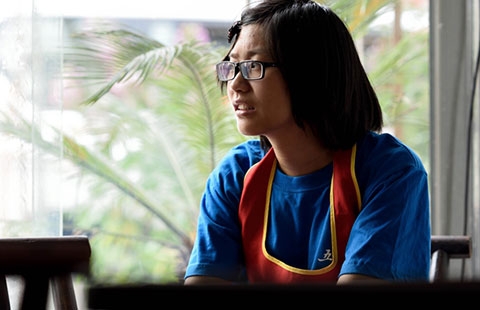China’s very own Kung Fu Panda
Updated: 2015-08-08 03:45
By ZHANG KUN in Shanghai(China Daily)
|
||||||||
 |
|
The third installment of Kung Fu Panda will be released on Jan 29, 2016. PROVIDED TO CHINA DAILY |
It has only been three years since its founding but Shanghai-based Oriental Dream Works Studio (ODW) is already on its way to launching its first feature film, Kung Fu Panda 3, in collaboration with DreamWorks Animation in the United States.
Scheduled for worldwide release on January 29, 2016, the latest installment of the blockbuster movie marks the first time that an animated film has two versions — in English and Mandarin. While there are no big differences between the versions, the Chinese film will feature characters with different facial expressions when they speak.
A new computer graphic technology was used to capture the facial expressions and lip movements of voice actors to ensure that the animations are in sync with the Chinese language. The Mandarin version will feature a star-studded cast of China actors, including action superstar Jackie Chan who also stars in the English edition.
“We are creating movies with a Chinese flavor for worldwide distribution” said Xavier Bernasconi, a digital supervisor at ODW. “The objective here is to tell Chinese stories to a worldwide audience.”
The first two installments of the Kung Fu Panda franchise, which boasted a lavish production budget of $280 million, was wildly successful at the box offices worldwide, grossing a total of $1.3 billion, and ODW is hoping the third will do “as well as the first two episodes,” said Yang Boning, a senior communications consultant with ODW.
Despite the similar names, ODW is not a subsidiary of the United States-based DreamWorks Animation, but an independent enterprise born from a joint venture between the American company and several Chinese partners, including China Media Capital, Shanghai Media Group and Shanghai Alliance Investment Limited.
Working on the film are more than 200 staff members in Shanghai, and another 300 from DreamWorks Animation in the US. “We have collaborated seamlessly on this project,” said Frank Zhu, vice president of ODW.
ODW also owns the copyright in the Chinese market for many of its American counterpart’s animations such as How to Train Your Dragon. DreamWorks Animation — which produced the first two films in the Kung Fu Panda franchise — owns a 45 percent stake in ODW while the Chinese investors own the majority.
“We and DreamWorks Animation jointly own the intellectual property of the Kung Fu Panda series,” confirmed Yang, who was speaking at the China International Cartoon & Game Expo on July 9.
In the North American market, the box office income of a successful animated film takes up no more than half of the total profits, and the rest comes from derivative merchandise. In the Chinese market, however, the box offices have always been the main profit source, with derivative products accounting for just 20 percent of the film’s total profit.
“Kung Fu Panda is an animation that has received international recognition for its Chinese characteristics. You can hardly find a second of its kind,” said Zhu, who added that this huge difference between the two markets has highlighted ODW’s potential in the derivative products segment.
To tap onto the popularity of the franchise, ODW’s creative team will be working with food, toy and stationery manufacturers to create Kung Fu Panda merchandise specifically for the Chinese retail market. These products are expected to hit stores in conjunction with the film release, Zhu added.
ODW is currently also working on a series of feature films at its new home on the west bank of the Huangpu River, but the studio is tight-lipped about its projects. Yang, however, did reveal that the studio will be engaging more Chinese artists in its creative and production processes, and that ODW’s portfolio will not just feature animations, but also fictional films, internet content and television shows.
China had in the past decade started a series of initiatives to support the animation industry and has as a result nurtured hundreds of grassroots studios. Many of the Chinese artists working at ODW are from these studios. ODW employee Chen Xiang, who has been an animator since 2000, said: “Kung Fu Panda 3 is a chance for first-timers like myself to go through the whole process of making a big-budget feature film that involves massive investment and hundreds of people.”
zhangkun@chinadaily.com.cn
- Kung Fu Panda in Hangzhou
- Kung Fu Panda in Beijing staged in New York City
- 'Kung Fu Panda 3' continues as tribute to Chinese culture: director
- 'Kung Fu Panda 2' leads Annie Award nominations
- Chengdu has starring role in Kung Fu Panda 2
- Is Kung Fu Panda 2 a cultural invasion?
- 'Kung Fu Panda 2' to hit silver screen in China
- Some 200 migrants believed dead in Mediterranean shipwreck
- Chinese FM rejects Philippine, Japanese, US claims on South China Sea issue
- 'Major breakthrough' may help solve riddle
- Hiroshima marks 70th anniversary of bombing
- World 'watching' Japan's next move
- Migrant boat capsizes in Mediterranean, at least 25 dead

 30 historic and cultural neighborhoods to visit in China
30 historic and cultural neighborhoods to visit in China
 Beijing Museum of Natural History unveils 'Night at the Museum'
Beijing Museum of Natural History unveils 'Night at the Museum'
 Sun Yang wins third consecutive 800m free gold at worlds
Sun Yang wins third consecutive 800m free gold at worlds
 Aerial escape
Aerial escape
 Freshmen of top universities from poorer families work part time to reduce family burden
Freshmen of top universities from poorer families work part time to reduce family burden
 17 armed forces take part in Russia military contest
17 armed forces take part in Russia military contest
 A glimpse of traditional Chinese business blocks
A glimpse of traditional Chinese business blocks
 Top 5 most popular drones in China
Top 5 most popular drones in China
Most Viewed
Editor's Picks

|

|

|

|

|

|
Today's Top News
China willing to work with US to contribute to world peace, stability
China asks further investigation on MH370
Police fatally shoot ax-wielding man at Nashville movie theater
Study-abroad tours in US booming
Malaysia confirms plane debris is from Flight MH370
IMF to study yuan inclusion
LA clinic seeks fertility-market access
China and US discuss ways to fight terror
US Weekly

|

|






